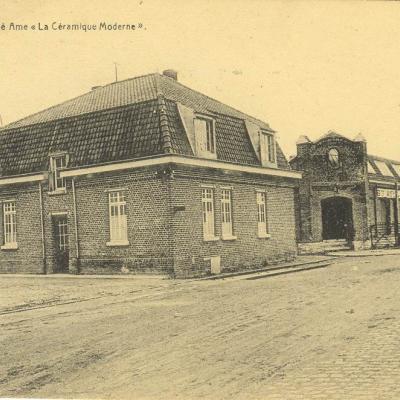A large 25.75m2 antique Rebaix floor with triple borders c.1920-1930
Complete with its original same size and half size borders, this reclaimed and now fully restored antique Belgian ceramic is reverse stamped ‘R’ Made in Belgium, having been manufactured by Societe Anonyme Ceramiques Modernes Rebaix, Belgique. The company commenced producing 16cm sq ceramic tiles just after World War 1 and we include in the gallery a scan of their factory. We would date these 14cm sq field, borders and 14cm x 7cm small borders to 1920-1930.
The floor, in a faux mosaique styalised vegetal theme popular in the 1920’s, is framed by a same size and half size border, which is laid in duplicate. All four large border corners and eight small border corners have been reclaimed.
This is a quality ceramic in excellent condition and slip colours are beautifully crisp as the high resolution photographs in the gallery show. A small number of tiles display the occasional groutable chip or edge nibbles to be associated with a floor around 100 years old. The photographs in the gallery are of a random section of the floor, which arrives fully restored and ready to relay. As a highly fired tile they can be laid inside or outside of the home and will work very efficiently with underfloor heating systems.
The floor totals 25.75m2 / 277 sq ft and there are also a number of free reject tiles with the floor for keying, using as halves or (should you prefer a rich antique patina integrating into the floor when laying)
Tile quantities:-
FIELD – 1,000 tiles - 20m2 / 215 sq ft.
LARGE BORDERS - 150 tiles plus 4 corners - 3m2 / 32.5 sq ft or 21.6 linear metres / 70.8 linear feet
SMALL BORDERS – 275 tiles plus 8 corners – 2.74 m2 / 9 sq ft or 39 linear metres / 128 linear feet
NOTE
Antique tiles were most commonly made in single or two tile moulds. Before current computer automation methods their moulds were made my hand and the colour slips mixed by eye. Kiln temperatures could also be variable, as could the firing time. The result is that often tiles display subtle size and thickness variations and there can be tonal variations in colours, owing to the slip mixing and/or firing time. All of this makes these handmade tiles unique and adds to their charm. Some floors display their subtle variations in size and tones, some not, but when photographing we always take a random section of the floor so that it is representative of the whole. A tiler should always dry lay a section of the tiles to familiarise himself with them before starting to fix lay.
MAD84





